Ladybugs are considered a symbol of organic farming. They are one of the most beneficial insects farmers can have in their gardens. They not only make your garden look pleasing but have a voracious appetite for plant-eating pests and insects like scales, mites, leafhoppers mealy bugs, aphids, and lots more. In one lifecycle, these small bugs can prey on more than 5000 bugs. Those special characteristics make them one of the best ways to remove parasites from your garden. The best part is, ladybugs also feed on insect eggs. Hence, they can also help in reducing the number of parasites and pests that grow in our garden. That is why ladybugs are often called as the lions of the garden. This article will help you about how to attract ladybugs to garden. So that they can help you raise your organic farm in the best way possible.
How to attract ladybugs to garden
There is several ways to attract ladybugs. Those ways about How to attract ladybugs to garden is given below
- Use plants that attract ladybugs
- Create some shelter for ladybug
- Make Ladybug feeder
- Avoid using any kind of insecticides
- Use ladybug attracted chemical
- Put some water in water pot in the garden
Now let’s talk about in detail how each of this process works
1. Use plants that attract ladybugs
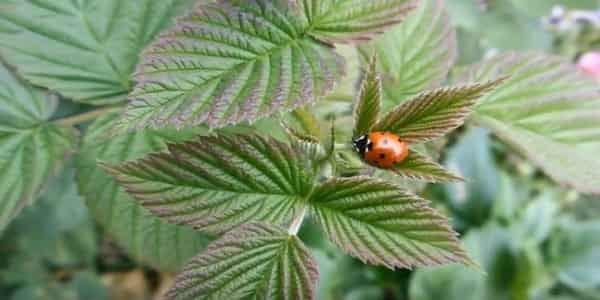
Just like other insects, ladybugs are also on the lookout for pollen as a food source. Hence, there are a number of plants that can be used to attract ladybugs in your garden. Some of the most common ones are:
1.1 Dandelion

Known as the lion’s tooth in most parts of the world, these flowers have massive quantities of pollen and attract ladybugs in a huge number. The best part is, they look quite pretty in your garden. In most regions, ’ dandelions are used for infusions and decorations. Hence, they will do much more than just attracting ladybugs for you.
1.2 Calendula

This flowering herb belongs to the ‘Aster’ family and is known for its medicinal and therapeutic properties. It is an edible flower that blooms in the summer and is one of the plants that ladybugs adore. Calendula flowers have a lot of pollen in the center which is why they are usually the main source of food in most gardens. The best part is, they grow rather easily and can survive in small pots as well.
1.3 Bluebottle
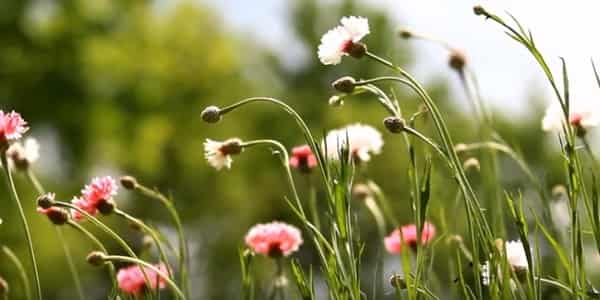
Usually known as the bachelor’s button or cornflower, the blue bottle is an annual flowering plant and is commonly found as a weed in cornfields. These flowers are known for attracting ladybugs because of their color and a large amount of pollen found in it. Even though they are considered a weed in a corn garden, flower enthusiasts have recently started planting blue bottle beds in their gardens due to the vibrant colors. They don’t have any medicinal properties but are easy to grow and maintain.
1.4 Mint

Most people don’t know this, but mint plants attract ladybugs like anything due to the unmistakable aroma. The best part is, the mind is a handy plant and can be used in many things. It can be grown in pots as well as on the ground without the added maintenance. It also makes your garden smell good.
1.5 Other plants
On top of the plants mentioned above, other plants that can be used to attract ladybugs include Tormentil, Geranium, Mulberry, Garlic, Parsley, Dill,Tansy, Fennel, Butterfly Weed, Common Yarrow, Bugleweed, Cosmos, Maximilian Sunflower, Caraway, Angelica, Statice and a few others.
2. Create some shelter for ladybug
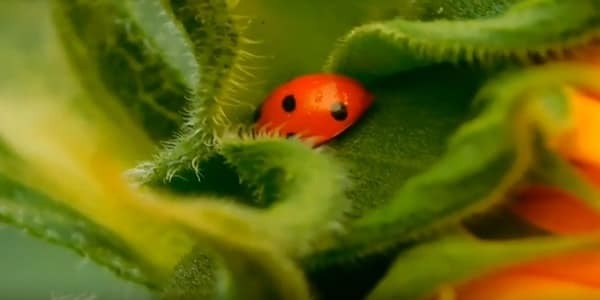
Just like any other insect or as a matter of fact, just like any species, ladybugs like to live in areas where they find enough shelter and cover. The shelter and cover are required to keep these little buggers safe from the effect of weather as well as from other predators. Unlike the common misconception, providing cover and shelter for ladybugs is not at all difficult. A few things that you need to do are:
2.1 Ground Cover

Covering the ground with leaf foliage, thick grass, or some straw will provide enough hiding spots and cover to these insects to survive. Mulch straw is another very useful way of providing shelter to ladybugs. These straws have a number of places that work as very efficient hiding places. This ground cover, whether it is leaf foliage, mulch straw or grass, will help the soil regain its nutrients as well. Hence, it is a win-win situation.
2.2 Stocky plants
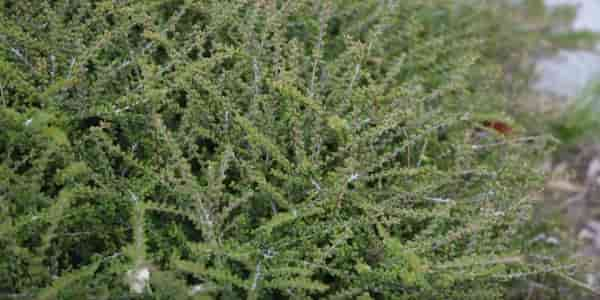
You might have noticed that the stocky and low-lying plants are where most of the insects hide. This holds true for ladybugs as well. Plants that are close to the ground and are dense provide them with good shelter and cover especially from predators. Usually, birds and frogs pray on ladybirds, so these dense and low-lying plants help them keep safe from birds that decide to take a plunge on them and from frogs as well. Plants like thyme and oregano are known to provide good cover.
2.3 Ladybug home
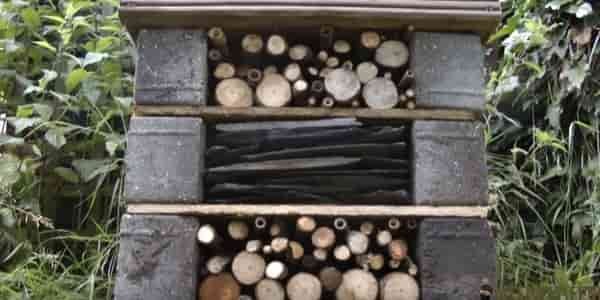
Yes, things like ladybug homes do exist. Ladybugs always need dark and dry areas to live in and that is where they flourish the most. Also, they need small dark and dry areas to lay eggs; if they don’t, they will probably move to another garden during the mating season. Hence, the best option is to build shelters, also known as ladybug homes by yourself. You don’t need any special equipment or materials to build a shelter. Just hanging a hollow tube with some twines will do. To make the home tempting, you can add food like raisins inside it until they get used to the new home.
3. Make Ladybug feeder
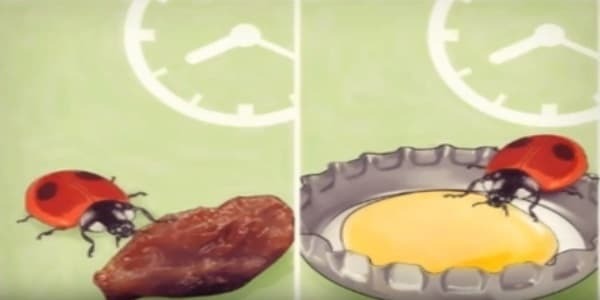
Sometimes, even if you have the best plants planted for attracted ladybugs. The efforts are in vain due to one reason or another and in most cases, buying ladybugs and releasing them in the garden in not preferred. At least not until you have tried everything else because this comes with a set of risks. Anyways, apart from planting pollen-rich plants and creating a good shelter for these insects, ladybug feeders can be extremely useful. The best part is, these ladybug feeders are neither expensive nor require a lot of material and effort.
All you need is a hollow stick, preferably bamboo since it can endure weathering, garden twine/chain, a few raisins and some cutters.
3.1 Making the feeder
Bug feeder almost looks like a bird feeder but much smaller. Depending on your liking, decide what size do you want the feeder in. Using a ruler and a pencil, make a mark on the hollow bamboo stick accordingly. Now at this point, you need to understand that the only tricky part about making the bug feeder is the cutting of the stick. You don’t want to cut right through in a straight manner. The opening should be enough for minimum sunlight and air but not enough for water to seep in. Hence, gardeners usually cut it at a 45 degrees angle. You don’t have to measure the angle exactly, but roughly cutting it along those measurements will do.
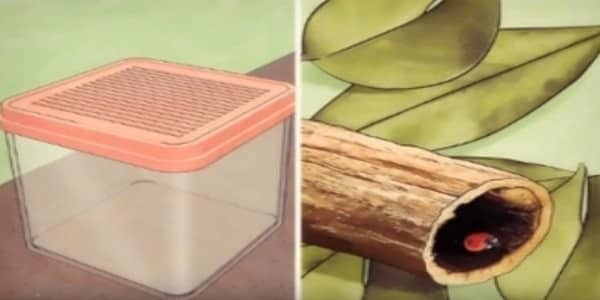
The next step is drilling holes in the bamboo. Make sure they are according to the size of the twine or chain you have chosen. Once the holes are drilled, secure the twine or chain in the bamboo stick and make a double knot at both ends. Lastly, add a few raisins inside the feeder.
3.2 Deploying into the garden
Fixing the bug feeder near a food source is the best way to attract ladybugs. You can, of course, tie it to a tree but that will only attract a few bugs. Fixing it in a rose bush or near pollen-rich plants will give you the best results. Refill the feeder with raisins every few days.
4. Avoid using any kind of insecticides
This is pretty much common sense. Insecticides and pesticides are not selective. Along with killing the pests that harm your garden, pesticides and insecticides kill all the beneficial insects as well. Hence, using any kind of insecticide, even remotely potent, will end up poisoning your ladybugs. Thus, it is better to stray clear of any and every insect-killing chemical whatsoever.
5. Use ladybug attracted chemical
There are a number of ladybug attractants available on the market. These things are specifically designed to help home gardeners make the most of their produce. They are an exceptional tool for attracting ladybugs in greenhouses and organic gardens.
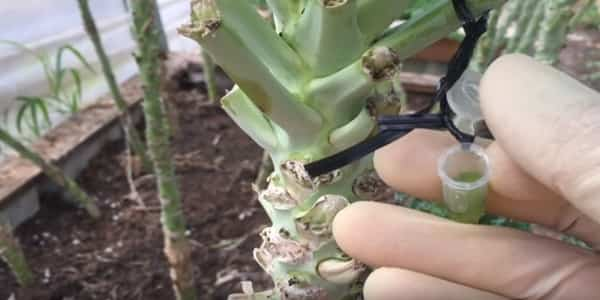
The attractant chemical basically replicated the smell of lady bug’s favorite food, which attracts them to your garden as a natural predated. The attractant usually comes in small capsules that are hung at different places in the garden. Over a time period of 4 weeks, the membrane in the capsule releases effective rates. Most chemical attractant companies prefer that gardeners use a single capsule for 200 square feet area.
6. Put some water in water pot in the garden
Just like all the other species on the planet ladybugs also need water for survival. Hence, placing water sources at different spots in your garden will attract them as well as will help in promoting a longer life.

You can use the basic chick water dispenser easily available at any store or you can use simple 2-inch deep trays or dishes. The best way to dispense water for ladybugs is to place a tray for 200 square feet area. Moreover, it’s better to make the water source look natural, so adding some stones or gravel at the bottom of the tray will be ideal. Make sure you add enough water to cover the stones. Anything less or more will not work.
Benefits of ladybugs in the garden
As mentioned, ladybugs along with praying mantises, are one of the most beneficial insects for your garden. This is mainly because of their voracious appetite for pests and their eggs. They eat anything and everything from aphids to spider mites to mealybugs. Some of the benefits of having ladybugs in your garden are:
Larvae
Ladybugs are known for laying their eggs in areas where aphids and other preys are in abundance. Hence, as soon as the eggs hatch and larvae emerge, they start feeding the insects. This means the gardeners don’t have to worry about the declining number of adults in case there is a disease of a catastrophe. The larvae are as good as adults in keeping pests at bay.
Eats Eggs
Ladybugs not only prey on insects that are harmful to the garden but are also fond of eating eggs. This way, they not only keep the adult pests in control but also keeps the larvae in control, inhabiting the future generations of these harmful insects.
Pollination
Apart from keeping the garden clear of pests, ladybugs are known for pollination of the plants as well. This leads to the production of fruit that we eat.
Thus, overall, ladybugs only bring benefits to the garden in the summertime. However, in winters, they can be a little inconvenient since, to find warmth, they start coming inside the house.
What do ladybugs eat
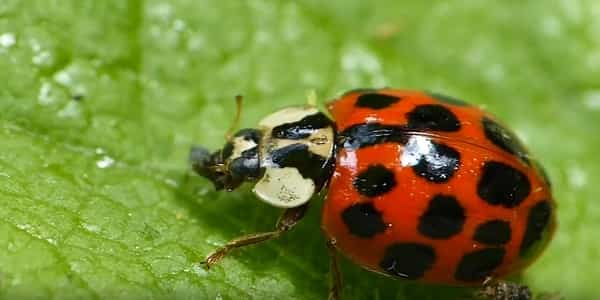
Diet-wise, Ladybugs are pretty versatile. If they don’t find any mealybugs, they can fulfill their requirements by eating pollen. However, in most cases, they prefer insects with small bodies such as mites, whiteflies, aphids (their favorite) as well as scale insects. As mentioned, these little buggers also prey on pest eggs and larvae. Hence, except for the plants in a garden, they eat almost everything. Moreover, in the winter season, if a ladybug decides to hibernate in your house, they will not eat anything but will live off on their body fat.
FAQS about ladybug
Some of the frequently asked questions about ladybugs are:
1. How long do ladybugs live?
Once the adult ladybug comes out of pupal age, it will live for one year before dying.
2. How long do the eggs take to hatch?
The time taken by eggs to hatch depends on the temperature. Usually, if the temperature is ambient after the female lays eggs, they take seven to ten days to hatch. After that larvae take 30 days to grow up and enter the pupal stage that lasts for 15 days.
3. Do all classifications of ladybugs get rid of pests?
Yes, ladybugs have more than 20 lower classifications; however, all of them are beneficial for your garden and will eat up all the pests in the garden.
4. How do they survive in winter?
In winter, ladybugs look for humid and warm atmospheres. Thus, in most cases, they go inside the house and hibernate.
Conclusion
This article was all about helping you understand the basics of how to attract ladybugs to garden. Ladybugs are very beneficial when it comes to organic gardens. They eliminate the need for using pesticides and insecticides which are not only harmful to the plant’s produce but are also unhealthy for humans to consume. Moreover, they are not a very eco-friendly option either. When that insecticide sweep into the ground resulting in the killing of nutrition. Fruits with insecticide and pesticide residue are known to affect the good animals that consume them adversely. Hence, attracting ladybugs or other beneficial insects like praying mantis to your garden will keep the pest population in control.
It will also give you an eco-friendly alternative for your garden. Besides using beneficial insect-like ladybug to control pest, the bug zapper is also helpful to control some flying insects and also a good alternative of pesticide. So if you wish can also check our top bug zapper reviews.
So that’s all for today, hope to come up with some more helpful post for you people in the near future. If you have any question please let us know in the comment section, we always love to hear from you.

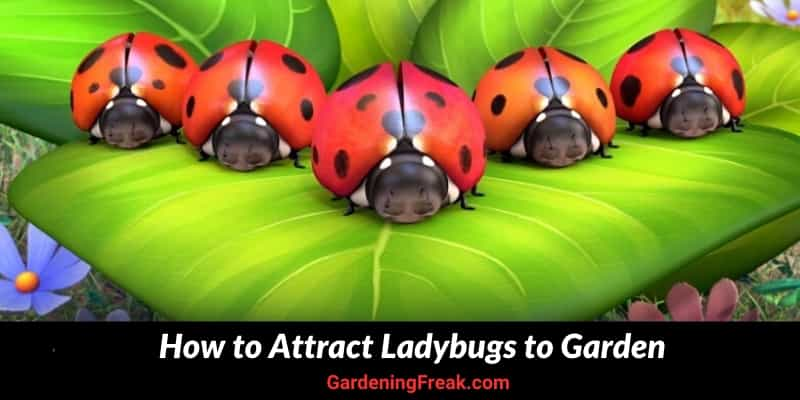










Hi there to every body, it’s my first pay a visit of this web site; this website contains awesome and
in fact good information for visitors.
Thanks for the compliment…
[…] will also give you a deeper insight into them. One of the organic ways to control them is to attract ladybugs inside the garden. There are also some other way that we will discuss here […]